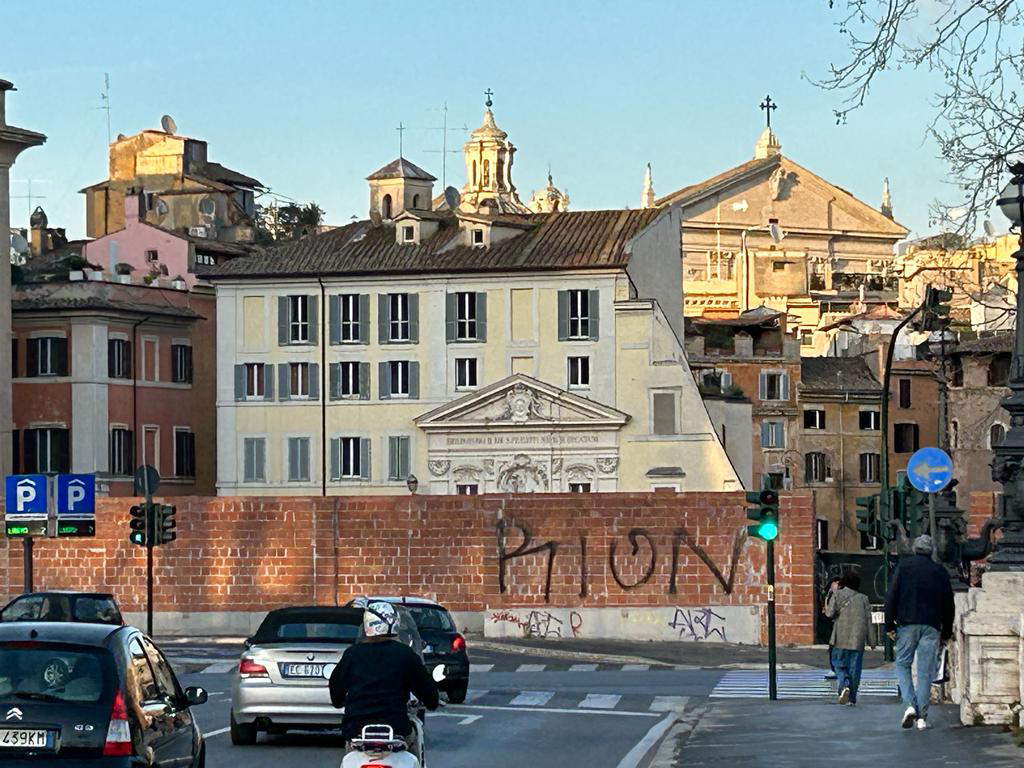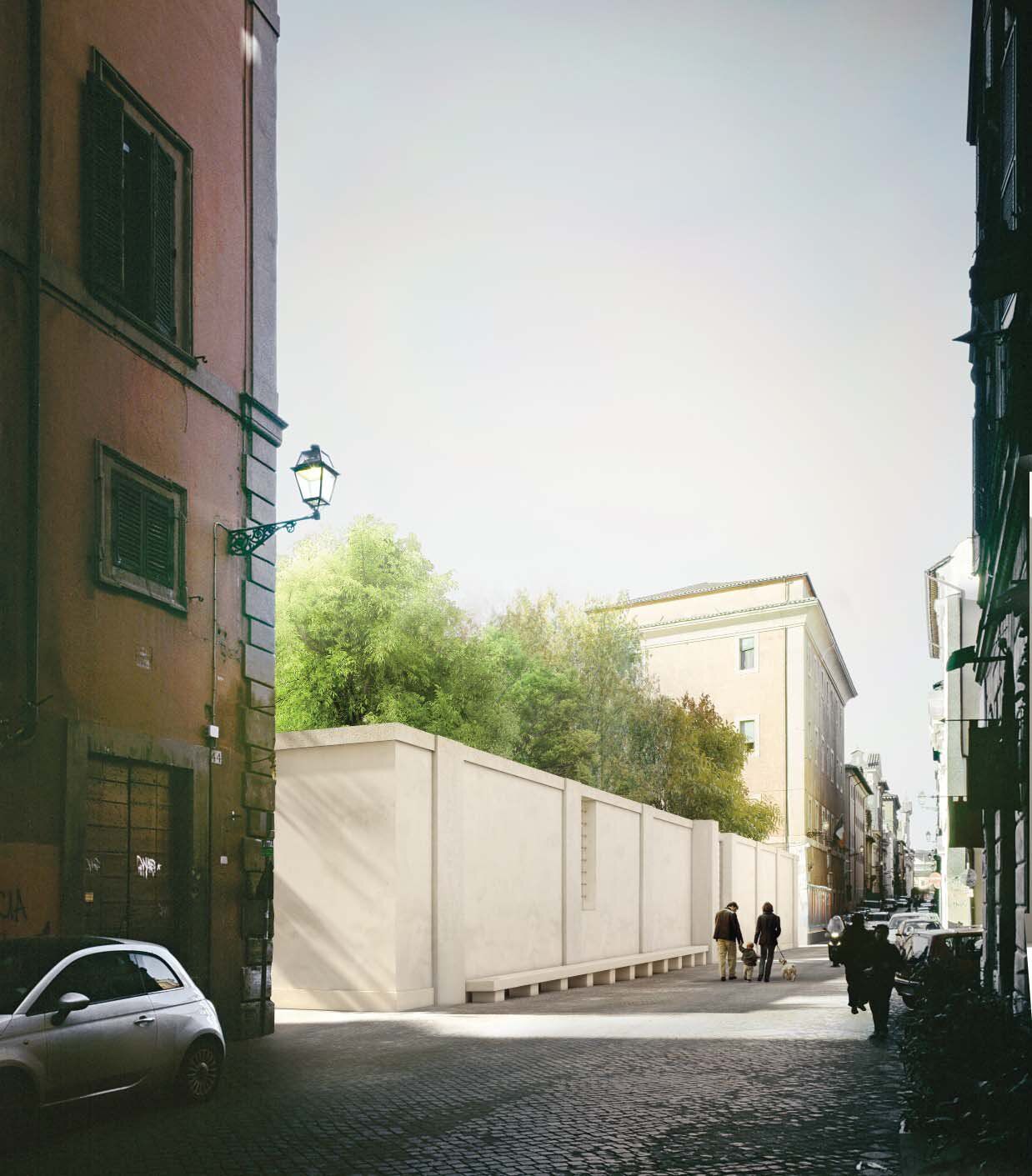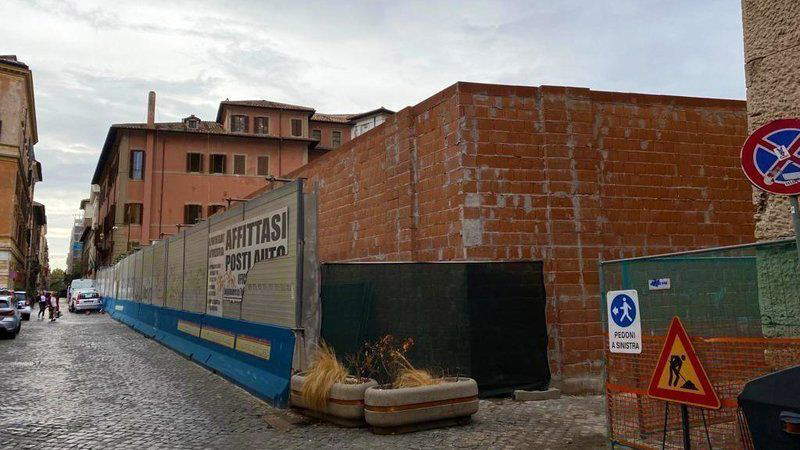A 5-meter-high wall has been towering for more than a year on Rome’s Via Giulia. An incomprehensible wall that devastates one of the most beautiful landscapes in the world and was built to protect a baroque garden that will not be realized due to design errors. “Every time we talk about Rome we always end up using resigned tones,” writes the promoter of the appeal “No Wall”, a movement born around this battle and that is obtaining thousands of signatures on the petition that has been asking Mayor Gualtieri for years to reconsider and modify this project that started more than fifteen years ago and that seems useful only to justify the construction of a maxi parking lot within an area that Unesco declared, in the 1980s, a world heritage site.
Any ordinary Roman citizen who decides to change the color of his or her shutters or tweak even slightly the design of his or her home would run into labyrinthine bureaucratic constraints, if not fines and criminal penalties from the superintendencies. Because in Rome there are two superintendencies, that of the Municipality and that of the State. Two very powerful bodies that not infrequently give conflicting opinions. But on the Via Giulia wall the bureaucracy seems to have no doubts: it has to be done because some bureaucrat has decided to do it and no one wants to take the responsibility of modifying a project even in the face of glaring procedural, design and implementation flaws. A movement has been born against that wall; it is called NO WALL and, in this article, we host a contribution expressing the point of view of its president, architect Fabio Mazzeo, who, in addition to issues of design approach, draws attention to what a masonry fence, so invasive and aggressive of an urban space in a central area of a capital city like Rome, can represent, also in terms of safety and maintenance.

 Hands
Hands Hands off
Hands offWhenever we talk about Rome we always end up using resigned tones. One is struck by the habit this city inspires in the use of certain adjectives, used in pairs, often sadly conflated, sides of the same coin that, in fact, one finds it hard not to share. Beautiful, but dirty; romantic, but decadent; iconic, but scarred; attractive, but chaotic; welcoming, but exclusionary; open, but stuck, a city jumble of qualifying contrasts that disarms and that despite the yearning to love it even for its imperfection, often ends up generating anger and frustration. Of course, it is true, it is usually a certain imperfection that makes things more attractive, since it is not so rare that perfection (if it even existed) creates a certain emotional discomfort, almost a sense of sentimental estrangement, but in Rome, at least this risk is not taken.
Of opportunities to feel anger and frustration Rome offers just so many and has always offered them even in places like the historic Via Giulia where, less than in others, one would expect to suffer from that vocation in being a dual and controversial city. Via Giulia is a beautiful, historic street that is particularly important to the fabric of Rome at the turn of the Renaissance and Baroque eras, and yet it is experiencing a drama that will most likely end in one of the saddest and most incomprehensible missed opportunities of recent decades.
That of the long-standing problem of the “baroque garden” planned in the Largo Perosi area of the VII Rione Regola in the center of Rome between the Tiber and Via Giulia, is but yet another tragicomic reason to return to reflect on how much this city suffers from a certain intolerance to change and an innate procedural perversion in the activities of its administrative machine.
It all began in February 12, 2008, the year in which a Municipal Ordinance authorized the signing of an agreement for a new partially underground parking lot with access from Lungotevere de’ Tebaldi. From that moment on, a whole series of episodes related to a possible new use of the surface part of that parking lot, a strategic area between Via Giulia, precisely, and the Lungotevere, would take place. So many different projects, including even a 5-star hotel, will end up on the tables of municipal administrations of all colors, Superintendencies, I Municipio, passing through the MIBACT and citizens’ associations, according to what in my opinion has been a “procedural Russian salad.” It will end up opting, only in 2015, for the project of a garden, a garden however “baroque” enclosed by a very high wall, almost 5 meters high, to restore what, according to the intentions of Donato Bramante, in 1508, would have guaranteed the perspective axis of the street. An intention that is certainly noble and of all respect from a historically philological point of view, which, however, appears tragically inconsistent if by “high” only a wall is left given that that (baroque) garden inside it, seems to have major construction impediments due to the poor bearing capacity of the subfoundation slabs.
In other words, we are faced with the problem, including urban planning, of having an area to be re-functionalized, along a wonderful street and finding ourselves subjected to an idea that everyone now, including those who administer, after 15 years of controversy deems wrong, but which the bureaucracy intends to pursue anyway by diabolically persevering in a procedural mess inherited in land management. A program void that adds up to that other urban void, now improperly named “Piazza della Moretta” (read “alley”) from the Renaissance era. Voids that, of course, again, as in so many others are perfectly recognizable, alas, not by the beauty of its well-kept furnishings or flowers, by the people who stroll there and the kids play there, but by the chaotic pattern of wildly parked cars. One could then organize, with the help of simple furnishings and thematic gardens, areas for resting and walking, areas for children’s games and sports, perhaps with a wrought-iron fence, permeable to view, that would allow the urban fabric a chance to breathe by enlarging the lungs of a fabric that increasingly suffers from invasive vehicular traffic that is now largely out of scale in comparison with those places.
It might be time to rethink those areas strategically, without “fencing” them with brick curtains nearly five meters high in a clumsy attempt to bring back to memory Renaissance concepts of Bramante origin that today would exclude any possibility of perspective expansion, unreasonably isolating and impeding the horizon of the Tiber and the Janiculum from Vicolo della Moretta, effectively mortifying every possible opportunity to create places of new and open sociality, while respecting decorum and attention to safety. And it is precisely safety that, in our opinion, makes even more evident the weakness of a solution that now seems as inescapable as that of completing the wall that has been partially built for months. Yes, because such a high wall, built right there, next to the offices of the National Anti-Mafia Prosecutor’s Office, not only divides, excludes and prevents views, but also hides and creates ravines that are difficult to guard; perfect places to accommodate social decay and facilitate abandonment, unless there is continuous maintenance and an impressive video surveillance system that would, in fact, impose greater costs and a demanding, reinforced police presence. I do not believe that Via Giulia and Rome itself deserves this.
It is easy to wonder if this disqualifying process is really inevitable; bureaucratically unstoppable like so many other events that, incredibly, affect the Eternal City. A kind of curse that is fulfilled at every attempt to bring functional and ameliorative solutions to life, balancing the complex equation with such unknowns as: the utility and social welfare in the enjoyment of the city and the protection of the artistic, archaeological, and architectural heritage; a trap that is triggered, as with Via Giulia for the past 15 years, through the usual and unhealthy protocol of the best Capitoline traditions that, regardless of the colors of each of its administrations, manages to demonstrate surreal and articulate managerial inefficiency. So much more than solving equations!
I’m sure that even Donato Bramante, designer of that beautiful street, when faced with such a context and, above all, with that “urban gap” would advise giving value to the “absence,” making it urbanistically integrated, instead of specifying and holding it back, forcing it into an impenetrable, unsafe and unjustified perimeter.
Warning: the translation into English of the original Italian article was created using automatic tools. We undertake to review all articles, but we do not guarantee the total absence of inaccuracies in the translation due to the program. You can find the original by clicking on the ITA button. If you find any mistake,please contact us.